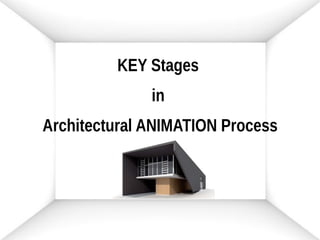
Key Stages in Architectural Animation Process
- 1. KEY Stages in Architectural ANIMATION Process
- 2. Attaining & Organizing Data ● Getting the plans, sections, elevations, detail drawings, landscape plans, lighting plans... etc from the client. ● Organize your files in a clear and simple structure; Nothing more counter productive than spending loads of time sifting through unorganized files
- 4. Client Communications ● Find out their target audience, the style they are going for and how the animation will fit in with their other marketing materials. ● How long the animation is to be, the soundtrack, the theme, text, captions... etc need to be discussed.
- 5. ● Make suggestions that you think will improve the look and feel of the project, being a 3D modeling and animation expert. ● Keep your client in the loop throughout the entire animation process; Send them preliminary images as often as possible.
- 7. Story-boarding ● Plan out each scene in your animation. ● Take into consideration the tempo of the soundtrack. ● For a complex model with millions of polygons, to fit everything into the one scene you will end up with a really big file size. ● It best to create a file/scene for each camera path.
- 9. 3D Modeling ● Include as much detail as possible - but only in the areas that need it. ● Don't go modeling blades of grass if they are going to be way back in the background! ● Put detail in to the areas that are close to the camera, will be clearly visible in the camera path.
- 11. Basic Lighting and Textures ● First, put some really basic lighting into the scene and in the test renders. ● Then, apply materials to all your objects, keep them simple! ● Now, its time to start setting up the real lighting.
- 12. ● Confirm whether the scene is set during the daytime or at night, inside or out. ● Tweak everything - lighting, materials, render settings... etc.
- 14. Advanced Lighting and Textures ● Keep working on the look of your scenes. ● Optimize your settings so that your render time for each frame isn't too long ● Add glossy reflections and increase your subdivisions. ● Have a good sized render farm, render out a low resolution version of the animation, send it to the client and confirm, before you move onto the higher resolution sequences.
- 16. Rendering ● You need to optimize your scene for quality vs speed. ● Use appropriate vray settings for huge render farm and render settings for others.
- 18. Editing ● Bring all together with your favorite video editing tool. ● Play around with colors, depth of field, motion blurring... etc.
- 20. Architectural animation process can be daunting and complicated despite the passion for it, unless neat and clear planning is done. These stages may not be absolute right way, but can be beneficial to see the process we go through.
- 21. www.veetildigital.com.au Perth | Sydney | Brisbane
